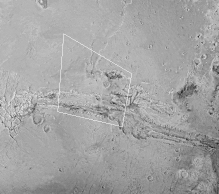Surveyor Mission Remains on Target Despite Glitch
News story originally written on October 20, 1997
The Mars Global Surveyor arrived at Mars on September 11, 1997. The spacecraft had already begun its aerobraking procedure that would bring it into a low orbit around Mars so that it could map the entire Martian surface. Unfortunately, this aerobraking has been interrupted because one of the Surveyor's solar panels has not completely unfolded.The solar panels were being used in the aerobraking procedure to create drag on the spacecraft as it descended through the Martian atmosphere. The fact that one of the panels was not unfolded endangered that solar panel as it was experiencing high drag pressure. This situation was also seen as unstable for the spacecraft as a whole. NASA decided to put a two-week hold on any further aerobraking in hopes of finding a solution to the solar panel problem. Decisions about the future plans for the Surveyor mission are expected to be finalized on Monday, October 27, 1997.
For now, the Surveyor is continuing to collect and return scientific data relative to the surface, atmosphere, and interior of Mars. Scientists remain hopeful about the overall Surveyor mission. Project manager Glenn Cunningham recently said, "The spacecraft, except for the uncertainty concerning the -Y solar panel, and all its instruments are working exceptionally well, and we continue to have great expectations for the discoveries that this mission will return."















